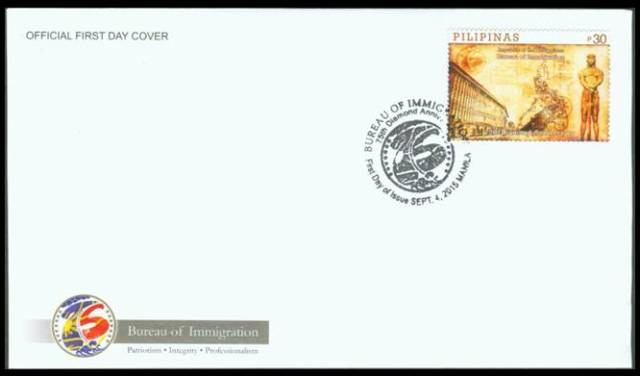2015, September 4. Bureau of Immigration, 50th Anniversary
Litho Offset, Amstar Company, Inc., Perf 14
Singles (Jumbo size), Sheets of 40

30p Immigration Building/Statue of Lapu-lapu, - Singles (55,000)
Layout Artist: Victorino Z. Serevo
Stamp Design: Bureau of Immigraton anniversary logo, stamped canceller, immigration badge, the Bureau's main building, and, Lapu-Lapu, the first Filipino to resist Spanish colonization.
First Day Covers: Manila

Bureau of Immigration - 75th Anniversary
The Bureau of Immigration started as a division of the Bureau of Customs during the American regime in 1899. This was pursuant to Act No. 702 of the Philippine Commission. It was appropriate because ship travel and ship cargo were interlinked and hence, the office was at the Bureau of Customs. It seems that the government then, gave more importance on the entry of goods than monitoring of foreign nationals coming into the country. The government was more interested in generating customs duties from these goods than in the control and regulation of the arrival and stay of foreigners. The functions of immigration remained under the said bureau until 1937 when it was transferred as a division of the Bureau of Labor.
The functions of Immigration were transferred in 1937 as a division under the Bureau of Labor. This was mainly to respond to the arrival of Chinese nationals who owned and operated trade houses stores and restaurants in the country.
On January 22, 1940, the Second National Assembly of the Philippine Commonwealth enacted the Philippine Immigration Act of 1940 (Commonwealth Act No. 613). It was signed into law by the President of the United States of America on September 3, 1940, creating the Bureau of Immigration under the administrative supervision of the Office of the President.
A year or so later, it became an attached agency of the Department of Justice. Later, its administrative control was returned to the Office of the President.
When the Pacific war broke out in December 1941, the bureau, then under the Department of Justice, moved to the Bilibid Prison on Azcarraga Street (now Claro M. Recto Avenue).
Immediately after the war, the bureau was transferred near the Gate 1 of the South Harbor in Manila, then moved to Building No. 5 at the Customs Bureau at Gate 4. In 1945, in line with the reorganization plan of the government, the bureau was put under the supervision and control of the Department of Labor.
In 1948, the Bureau was reverted to the jurisdiction of the Department of Justice where it has remained up to the present time.
On September 21, 1972, then President Ferdinand E. Marcos proclaimed Martial Law, through General Order No. 1, ordered and decreed the adoption and implementation of the Integrated Reorganization Plan.
Hence, the Commission on Reorganization issued Letter of Implementation No. 20, dated December 31, 1972 which embodies the plan, including among other things, the change of name of the office from the Bureau of Immigration to Commission on Immigration and Deportation. This became a collegial body and performing both administrative and quasi-judicial functions. It is composed of the commissioner and his two associate commissioners. Letter of Implementation No. 20 also abolished the Deportation Board and transferred its functions to the Board of Commissioners who gave them power to undertake deportation cases.
The bureau was given the sole authority to enforce and administer immigration and foreign nationals registration laws including the admission, registration, exclusion and deportation and repatriation of foreign nationals. It also supervises the immigration from the Philippines of foreign nationals.
On July 25, 1987, President Corazon C. Aquino signed Executive order No. 292, also known as the Administrative Code of 1987. Said order renamed the office, “Bureau of Immigration.” It continues, however, to perform all the powers and functions it had while still a commission, and its head of office still remains to be called commissioner as provided under DOJ.
-
Government Institutions
-
Arts / Statues
-
Map
